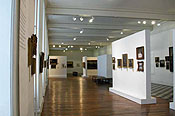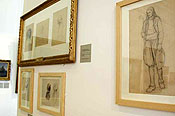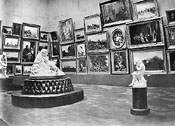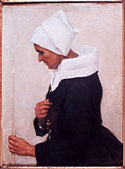The browser will either open the file, download it, or display a dialog.
|
"Jules Breton: La chanson des blés" Annette Bourrut-Lacouture |
|||||||
|
At last! A new Jules Breton exhibition! Anyone who has studied French painting of the second half of the nineteenth century can only be delighted with the initiative of the museums in Arras, Quimper, and Dublin to devote a major exhibition to the work of Jules Breton (1827–1906). There has not been a retrospective exhibition of his work at a European museum since the museum in Arras exhibited works by him and his brother Émile in 1976–77.1 The idea for the current display and joint operation between the museums of Arras and Quimper originated in 1990, but its realization has taken a long time and, in the meantime, the museum of Dublin joined as a third partner. All three museums possess significant works by Breton. | ||||||
| Like many of his contemporaries, Jules Breton (and his work) sank into oblivion not long after his death. It was not until well into the second half of the twentieth century that the works of academic painters—Jules Breton, Jules Bastien-Lepage, Ernest Meissonnier, and others—began to regain their stature. Credit for this renewed interest in Breton rests with the United States, for during his lifetime a considerable number of Breton's key works entered private collections and museums there. In the early 1980s, two exhibitions—one in Cleveland (1980), the other in Omaha (1982),2 brought this artist to the attention of the American public. | |||||||
| This current major retrospective, whose name is based on a comment by Vincent Van Gogh ("Breton c'est la chanson des blés"), covers every aspect of Breton's work and contains 118 works dated between 1847 and 1904; virtually all of Breton's most important paintings are present. Many of the loaned works are from the United States, where his imagery has been warmly received, so it is most unfortunate that this exhibition is not being staged by any museums there. Loans also come from French museums and other large Western European collections as well as a considerable number of private collections. | |||||||
| The first venue was the Musée des Beaux-Arts in Arras, the nearest museum to Courrières, where Breton was born. This museum is housed in an impressive building, the former Saint-Vaast Abbey, where one large hall contained the entire exhibition (figs. 1, 2). There was no overpowering and off-putting design; it was presented against a simple and neutral white background which offered visitors an immediate taste of what they came to see: the works of Breton, nothing more, nothing less. These works of art, briefly and effectively clarified in an introductory text, were mainly arranged in chronological order. Because the entire hall could be viewed in a single glance, it offered the visitor a unique and continuous opportunity to step back and compare, or to look ahead. Moreover, the placement of preparatory studies (chiefly smooth oil sketches but also splendid drawings) next to each important work was hugely instructive as, for example, the magnificent series of studies for Un grand pardon breton, 1869. | |||||||
| The exhibition begins with some pieces from Breton's younger days: his training, from 1843, first at the Academy in Ghent under the charge of his mentor, Félix De Vigne (whose daughter Elodie he was to marry in 1858), and, after a short interval in Antwerp, in Paris. Breton experienced the revolution of 1848 at close quarters, and because of family financial difficulties after the death of his father that year, he was forced to Courrières to live with his family. In 1853 he painted his first rural scenes, which were of his native region. In so doing, he "gave the simple peasants a place previously reserved for the gods and the powerful";3 it was these paintings that established his name. The most important ones have been assembled for this show: Les glaneuses; Courrières, Pas-de-Calais, 1854 (National Gallery of Ireland, Dublin); L'incendie d'une meule, ca. 1856 (The Detroit Institute of Arts); La bénédiction des blés; Artois, 1857 (Musée des Beaux-Arts, Arras); Plantation d'un calvaire, 1858 (Palais des Beaux-Arts, Lille); and Le rappel des glaneuses, Artois, 1859 (Musée d'Orsay, Paris). There are also some smaller works, such as a few country scenes and interior pictures situated in Courrières or Belgian Limburg. | |||||||
| In 1864, after spending two autumns in the region of Bordeaux, Breton painted Les vendages à Château-Lagrange; Saint-Julien, Médoc (Joslyn Art Museum, Omaha) and a year later traveled for the first time to another region, Brittany. He stayed regularly in Douarnenez until 1890 and studied the local residents' customs and clothing. This inspired him to new heights in his work, resulting in some splendid monumental paintings: Un grand pardon breton, 1869 (Museo Nacional de Bellas Artes, Havana); and Le Pardon de Kergoat, 1891 (Musée des Beaux-Arts, Quimper). The very popular Le chant de l'alouette, 1884 (The Art Institute of Chicago), is also linked to this theme. | |||||||
| The exhibition concludes with some portraits, such as the very modern one from 1897 of Lady Dorchain (Musée Municipal, Cambrai) and Breton's self-portrait of 1895 (Koninklijk Museum voor Schone Kunsten, Antwerp). This truly charming assemblage provides a reliable picture and complete overview of this "poetic" realist, who left behind a collection of passionate and endearing pictures whose subjects and occasionally delicate environments can still affect a viewer. | |||||||
|
Annette Bourrut-Lacouture, who supervised this exhibition and who is preparing a catalogue raisonné of Breton, has produced a splendid and abundantly illustrated catalogue to accompany the show, one that will prove indispensable for anyone interested in Breton and pastoral realism. Bourrut-Lacouture is also responsible for the Breton archives, and she has, quite rightly, made full use of these excellent primary sources (the artist's extensive correspondence, for example). |
|||||||
| After a preface by Geneviève Lacambre, general curator of the Musée d'Orsay, the life and works of Breton are examined chronologically. His family and childhood years in Courrières are examined first, then his discovery, at age fifteen, by Félix De Vigne. The early years are covered well in the book—more so than in the exhibition—and much is made of the importance of De Vigne's influence on the young artist's development. There are accounts of his training at the academies of Ghent and Antwerp with the most important Belgian artists of the 1840s: the painters Louis Gallait, François-Joseph Navez, Gustave Wappers, and Henri Leys, to name a few. To complete his training, Breton went to Paris in 1847, where in the mornings he worked in the studio of Martin Michel Drölling and in the afternoons copied paintings in the Louvre or the Musée du Luxembourg. He also attended classes in the early evening at the École des Beaux-Arts, where he was taught by both Horace Vernet and Jean-Auguste-Dominique Ingres! Attention is also given to the not inconsiderable influence of Ary Scheffer, with whom Breton and his friend Ernest Delalleau met each Sunday morning. The chapter on Breton's academic education concludes with an extremely valuable overview of the methods and techniques he used in his work. Bourrut-Lacouture discusses the brushes he chose, the importance of the "esquisse d'ensemble" (the exceptionally detailed studies he made in oil paint), and even the application of the layers of paint and the influence of photography. | |||||||
| An extensive chapter is devoted to Breton's involvement in the revolution of 1848. We are given the complete background for his first independent paintings, which include the two destroyed compositions Misère et désespoir (exhibited in 1849 at the Salon of Paris) and La Faim (exhibited in Paris in 1851 and later in Ghent and Brussels). These two realistic works show his sensitivity to daily life and contrast somewhat graphically with his entry in the Salon of Ghent in 1850, namely the painting Rêverie.4 Bourrut-Lacouture examines the influence of Léopold Robert in the transitional work Le retour des moissonneurs, 1853 (private collection, Ghent), a piece that represents the search for harmony between poetic reflection and the simplicity and genuineness of rustic life. | |||||||
|
Bourrut-Lacouture then concentrates on the first official successes, at the end of 1853, when Breton, once again in Courrières, was inspired by country life and had an abundance of models and subjects. He established a style in which the hard labor of rural life is idealized and his mostly female farmers and laborers are elevated into majestic figures. His success grew steadily, both in the official Salons and among the "bourgeois," who eagerly bought his work. His academic style was criticized, however. In 1863 Camille Lemonnier wrote about Breton's Sarcleuses, which was exhibited at the Salon of Brussels, and his words apply to Breton's style in general:
Even the recently completed painting La jeune mère (already sold to a man called De Poorter, a lawyer from Bruges) was not spared: "Here the head of the child is too bulky and the torso of the woman elongated in the fashion of a Hottentot; these two faults by M. Breton are unpardonable."6 The contrast between the work of Breton and that of the other major French master of rural life, Jean-François Millet, became increasingly apparent: "They are, respectively, at the heads of two schools that are radically and systematically different," wrote Ernest Chesneau in 1868, and "M. Breton never forgets that he is an artist . . . , and with one word he embellishes nature. In this way he achieves results that are more sympathetic and seductive to the public of the city. He is little smitten with reality and generally horrified by the peasantry. M. Millet, on the other hand, has consistently taken the part of brutal reality."7 |
|||||||
| Annette Bourrut-Lacouture discusses thoroughly the well-known works we associate with Breton with lavish quotations from original sources, fascinating reproductions of preliminary studies, and comparisons with the work of such masters as Millet and Charles Degroux. Reactions to his early work are covered, including his first major presentation of country life, Les glaneuses, Courrières, Pas-de-Calais, 1854 (Dublin), which gave him his first official success, a médaille 3ième classe at the Salon and Exposition Universelle of Paris in 1855. (The much more famous version of The Gleaners by Millet dates from 1857, and the one by Degroux is from 1856–57.) The author goes on to examine L'incendie d'une meule, ca. 1856 (The Detroit Institute of Arts), La bénédiction des blés; Artois, 1857 (fig. 3; Musée des Beaux-Arts, Arras; awarded a médaille 2ième classe at the Salon of Paris and purchased by the French government for 5,000 francs), Plantation d'un calvaire, 1858 (Palais des Beaux-Arts, Lille), Le lundi, 1858 (Washington University Gallery of Art, St. Louis), Le rappel des glaneuses; Artois, 1859 (Musée d'Orsay, Paris; awarded première médaille at the Salon of Paris), and Les sarcleuses, 1860 (figs. 4, 4a, Joslyn Art Museum, Omaha). | |||||||
| What followed was a period of searching: Breton painted an academic nude (Baigneuse, 1862, Museo Nacional de Bellas Artes, Havana), a historical painting (Consécration de l'église d'Oignies, 1863, private collection)—what he called his attempt at grande peinture—and spent some months in the autumns of 1862 and 1863 in the area of Bordeaux working on Les Vandanges à Château-Lagrange; Saint-Julien, Médoc, 1864 (Joslyn Art Museum, Omaha), a pendant to Les Sarcleuses commissioned by Count Duchâtel. He also created a group of smaller-scale works that were highly valued by the public: Une gardeuse de dindons, 1864 (private collection); the monumental Le repos, 1864 (Musée des Beaux-Arts, Arras); La fin de la journée, 1865 (The Walters Art Museum, Baltimore) in which Millet's influence is noticeable; and Le retour des champs, 1867 (private collection). Breton presented ten paintings at the World's Fair in Paris in 1867 (and won a first-class medal), and the following year began to take long sojourns in Brittany, in the region around Douarnenez. The author points out that it was in this period that Breton first made contact with the art dealer Samuel P. Avery, an association that was instrumental in the artist's popularity in the United States. | |||||||
|
The sea and the beach in Brittany inspired several of Breton's works, including Une source au bord de mer, 1866 (private collection), Fileuse, 1872 (Denison University Art Museum, Granville), and La falaise, ca. 1874 (Eric and Renée Weider Collection). Best known from this period are Un grand pardon breton, 1869 (Museo Nacional de Bellas Artes, Havana), the catalogue reproduction of which is of poor quality, and Le pardon de Kergoat, 1891 (Musée des Beaux-Arts, Quimper), paintings carefully and richly treated by Bourrut-Lacouture with regard to their origin, meaning, and realization (fig. 5). | ||||||
| From about 1870 Breton was a highly exalted artist, praised both at home and abroad. He was awarded an honorable medal at the Paris Salon of 1872, elected a member of the Institute in 1886, named "commandeur" in the Légion d'Honneur in 1889, and frequently chosen as a member of exhibition juries. (These official duties led him in 1897 to buy a hôtel in Paris, where he and his wife remained from 1900 until his death on 5 July 1906.) | |||||||
| Breton's work as a writer and poet is discussed in a separate chapter, followed by a painstaking examination of the artist's fame from 1870 on. This includes his participation in the official exhibitions, the effect of the turbulent developments in the exhibition system on his work, and his influence on the younger generation of naturalists, among them Bastien-Lepage and Léon Lhermitte. Coverage is also given to the reception and popularity of his work in the United States thanks to dealers such as Avery and Knoedler. For example, Le chant de l'alouette, 1884 (The Art Institute of Chicago) was seen only briefly at the Paris Salon of 1885 before it was bought by Henry Field and relocated to Chicago. | |||||||
| The final chapter, "La chanson des blés," explains the swift decline in popularity of this academic artist after his death and then gives a concise summary of his career, again highlighting the Millet–Breton contrast as well as Breton's influence on Western European painting. | |||||||
| The book concludes with a detailed list of the exhibited works, a chronological biography, a list of the Salons and exhibitions at which Breton's paintings were displayed (with an indication of which works are currently in public collections), and an extensive bibliography. A minor but unfortunate flaw is the lack of an index. Bourrut-Lacouture is currently working on Breton's catalogue raisonné and we are already looking forward to it. | |||||||
| Jan Dewilde Curator Ypres City Museums, Belgium Stedelijke.Musea@ieper.be |
|||||||
|
1. "Jules et Émile Breton, peintres de l'Artois," exhibition at Musée des Beaux Arts d'Arras, 1976–77, curated by Françoise Maison. 2. Gabriel P. Weisberg, The Realist Tradition: French Painting and Drawing, 1830–1900 (Cleveland: Cleveland Museum of Art, 1980); Jules Breton and the French Rural Tradition, edited by Hollister Sturges, with contributions by Gabriel P. Weisberg and Annette Bourrut-Lacouture (Omaha, Neb.: Joslyn Art Museum, 1982). 3. Jules Breton, La vie d'un artiste/Art et Nature (Paris: Lemerre, 1890), p. 177. 4. Académie Royale de Gand, XXIe salon triennal: Notice des ouvrages de peinture, sculpture, architecture, dessin, gravure, lithographie, etc. d'artistes vivants exposés au musée de l'académie la 30 juni 1850, exh. cat., Koninklijke Academie, Ghent (Ghent: D. J. Vanderhaeghen-Hulin, 1850), p. 21. 5. "M. Breton nous semble travaillé par une dangereuse préoccupation: il a voulu dorer la réalité de son sujet d'un reflet d'idéal . . . la fusion de ces deux choses, l'idéal et le réel, est presque impossible en de pareil sujets: il faut conserver tout entière à la poésie des champs sa grandeur robuste et inculte; les paysannes sont de vaillantes filles, au rouge sang fouetté par un incessant travail et non pas des bourgeoises affigées d'aspirations poètiques, qui se sont levées matin pour contempler l'aurore. M. Breton, qui est un grand poète, aurait dû comprendre cela." Camille Lemonnier, 1863. Salon de Bruxelles (Brussels: Ch. en A. Vanderauwera, 1863), pp. 14–16. 6. "Ici la tête de l'enfant trop volumineux et le sein de la femme allongé à la façon hottentote, sont deux fautes impardonnables chez M Breton." Ibid. 7. "Ils sont l'un et l'autre à la tête de deux écoles radicalement et systématiquement contradictoires," Ernest Chesneau, Les nations rivales dans l'art: Peinture, sculpture (Paris: Didier, 1868), pp. 306–9; "M. Breton n'oublie jamais qu'il est artiste . . . , en un mot il embellit la nature. Il arrive ainsi à des résultats plus sympathiques et plus séduisantes pour le public des villes, peu épris en somme de la réalité et à qui le paysan fait assez généralement horreur . . . . M. Millet, tout au contraire, a dès longtemps le parti pris de la réalité brutale. . . ."; ibid.
|







